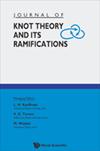钢轨电弧杆数
IF 0.4
4区 数学
Q4 MATHEMATICS
引用次数: 0
摘要
考虑$\mathbb{R}^3$中的两条平行线$\ell_1$和$\ell_2$。轨道弧是$\mathbb{R}^3$中的弧的嵌入,这样一个端点在$\ell_1$上,另一个在$\ell _2$上,并且其内部与$\ell1\cup\ell_2$不相交。轨道弧被认为是高达轨道同构,$\mathbb{R}^3$的环境同构,每个自同胚映射$\ell_1$和$\ell_2$到它们自己上。当流形和映射在分段线性类别中时,这些轨道弧被称为粘性轨道弧。轨道弧类的棒数是创建代表所需的最小棒数,即p.l.弧中的线段数。本文将计算交叉数至多为2的轨道弧类的棒数,并使用缠绕数不变量计算无限多个轨道弧类中的棒数。每个轨道弧类都有两个经典的相关节点类,即其下节点和上节点。本文还介绍了节点类的轨道棒数,即创建一个轨道弧所需的最小棒数,该轨道弧的下伴侣或上伴侣是节点类。对于交叉数最多为9的所有结类,均计算出轨道杆数。考虑了多分量轨道弧类的棒数以及轨道弧的晶格棒数。本文章由计算机程序翻译,如有差异,请以英文原文为准。
The Stick Number of Rail ARCS
Consider two parallel lines $\ell_1$ and $\ell_2$ in $\mathbb{R}^3$. A rail arc is an embedding of an arc in $\mathbb{R}^3$ such that one endpoint is on $\ell_1$, the other is on $\ell_2$, and its interior is disjoint from $\ell_1\cup\ell_2$. Rail arcs are considered up to rail isotopies, ambient isotopies of $\mathbb{R}^3$ with each self-homeomorphism mapping $\ell_1$ and $\ell_2$ onto themselves. When the manifolds and maps are taken in the piecewise linear category, these rail arcs are called stick rail arcs. The stick number of a rail arc class is the minimum number of sticks, line segments in a p.l. arc, needed to create a representative. This paper will calculate the stick numbers of rail arcs classes with a crossing number at most 2 and use a winding number invariant to calculate the stick numbers of infinitely many rail arc classes. Each rail arc class has two canonically associated knot classes, its under and over companions. This paper also introduces the rail stick number of knot classes, the minimum number of sticks needed to create a rail arcs whose under or over companion is the knot class. The rail stick number is calculated for all knot classes with crossing number at most 9. The stick number of multi-component rail arcs classes is considered as well as the lattice stick number of rail arcs.
求助全文
通过发布文献求助,成功后即可免费获取论文全文。
去求助
来源期刊
CiteScore
0.80
自引率
40.00%
发文量
127
审稿时长
4-8 weeks
期刊介绍:
This Journal is intended as a forum for new developments in knot theory, particularly developments that create connections between knot theory and other aspects of mathematics and natural science. Our stance is interdisciplinary due to the nature of the subject. Knot theory as a core mathematical discipline is subject to many forms of generalization (virtual knots and links, higher-dimensional knots, knots and links in other manifolds, non-spherical knots, recursive systems analogous to knotting). Knots live in a wider mathematical framework (classification of three and higher dimensional manifolds, statistical mechanics and quantum theory, quantum groups, combinatorics of Gauss codes, combinatorics, algorithms and computational complexity, category theory and categorification of topological and algebraic structures, algebraic topology, topological quantum field theories).
Papers that will be published include:
-new research in the theory of knots and links, and their applications;
-new research in related fields;
-tutorial and review papers.
With this Journal, we hope to serve well researchers in knot theory and related areas of topology, researchers using knot theory in their work, and scientists interested in becoming informed about current work in the theory of knots and its ramifications.

 求助内容:
求助内容: 应助结果提醒方式:
应助结果提醒方式:


